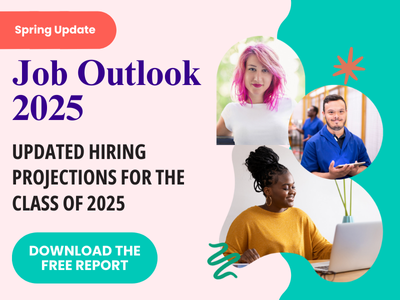The perception of college students is stereotypically a student between 18 and 20 years old who lives on a residential campus and has enrolled in college to prepare them for the start of their career. However, the reality is that this image does not capture the breadth of college students. The Lumina Foundation estimates that one-third of college students are 25 years and older; in graduate programs, students often return to complete advanced degrees years after earning their undergraduate degrees. This year, NACE took a deeper dive into its 2024 Student Survey data to provide a snapshot of the experiences of students who are 25 years old and older in undergraduate and graduate degree programs.
Nontraditional-aged students, defined as those 25 years or older, made up 24% of our 2024 Student Survey sample (N=2530). They represented students across undergraduate and graduate programs. (See Figure 1.) It is this sample of students that will be the focus of this article.
Figure 1: Nontraditional Students by Degree Program, Student Survey 2024
| N | Percent | |
|---|---|---|
| Associate | 270 | 10.7% |
| Bachelor’s | 904 | 35.8% |
| Master’s | 944 | 37.4% |
| Doctorate | 409 | 16.2% |
| Total | 2527 | 100.1%* |
What Resources Do Nontraditional-Aged Students Use in Their Career Search?
Nontraditional-aged students are less likely to visit the career center on campus than are traditional-aged students. In our survey, 38% of students 25 years and older visited the career center (either virtually or in person) as compared to 51% of students less than 25 years old. Of the nontraditional-aged students who did visit the career center, more than half of them (52%) sought help with their resume and/or cover letter, 37% went for general career advice, 34% searched out career exploration assistance; and 30% visited for help with their job search.
Similarly, nontraditional-aged students are less likely to attend career fairs than are traditional-aged students across degree programs. Twenty-nine percent of nontraditional-aged students attended a career fair in the past year as compared to almost half (49%) of traditional-aged students. Looking within nontraditional students, there was relatively even distribution across degree programs, with one-third of masters’ level students attending a career fair, and approximately one-quarter each of students earning an associate, bachelor’s, or doctorate degree.
Nontraditional-aged students also use a variety of resources in their job searches. Eighty percent reported using traditional job search websites, 67% used employer websites, and 43% used social media.
Nontraditional-aged students are more likely than traditional aged students to report that their institution prepared them well for the next step in their career. Sixty-one percent of nontraditional-aged students report that their institution prepared them very or extremely well, as compared to 54% of traditional-aged students.
How Prevalent Are Experiential Learning Opportunities for Nontraditional-Aged Students?
While close to half of nontraditional-aged students (48%) reported that they participated in some form of experiential learning, this share is far lower than the 61% of traditional-aged students. Furthermore, nontraditional-aged students (54%) were less likely than traditional-aged students (64%) to be paid for their experiential learning. Looking across degree programs, graduate students are more likely to participate in experiential learning opportunities, while associate degree level students have the lowest participation rate. (See Figure 2.)
Figure 2: Experiential Learning by Degree Type for Nontraditional-Aged Students (N=2526)
| Degree | Participated in Experiential Learning | Did Not Participate in Experiential Learning |
|---|---|---|
| Associate degree students | 31.9% | 69.9% |
| Bachelor’s degree students | 39.0% | 61.0% |
| Master’s degree students | 52.3% | 47.7% |
| Doctorate degree students | 67.5% | 32.5% |
Regarding type of experiential learning, internships, practicum, and on-campus student work dominate the opportunities in which students participate. Experiential learning has strong benefits for nontraditional-aged students. Among those students who participated in an experiential learning opportunity, 78% felt that experiential learning helped them determine whether a field still interested them for a career, and three-quarters reported that they wanted a career in the industry after the experiential learning opportunity. Not surprisingly then, the vast majority (88%) said that the work that they did was meaningful. Furthermore, 85% reported that the work experience taught them several things that they never would have been able to learn in the classroom.
What Are Nontraditional-Aged Students Looking for in Careers?
Nontraditional-aged students value flexibility in work modality. Almost half (47%) would prefer a hybrid work modality, 39% prefer to work fully in person, and 14% indicated a desire to work in a fully remote modality. In comparison, traditional-aged students are more likely to prefer fully in-person work over the other modalities. Fifty-six percent of traditional-aged students prefer fully in-person work, while 40% of them prefer hybrid and just 5% are looking for fully remote work.
In regard to job attributes, 80% of students report they look for job stability, 79% look for an organization that promotes healthy workplace culture, and 74% report that an organization that has a good insurance/benefits package is important. Looking specifically at benefits, 84% of students report that annual salary increases are very or extremely important, 75% report the importance of employer-paid medical insurance, and 71% strongly value the availability of dental insurance.
This article provides an overview of some key aspects of nontraditional-aged students’ experiences in college as they prepare for the next steps in their career. While some of their experiences mirror those of their traditional-aged peers, there are important areas where they diverge. This information can help career service professionals and recruiters better serve this growing group of college students.






